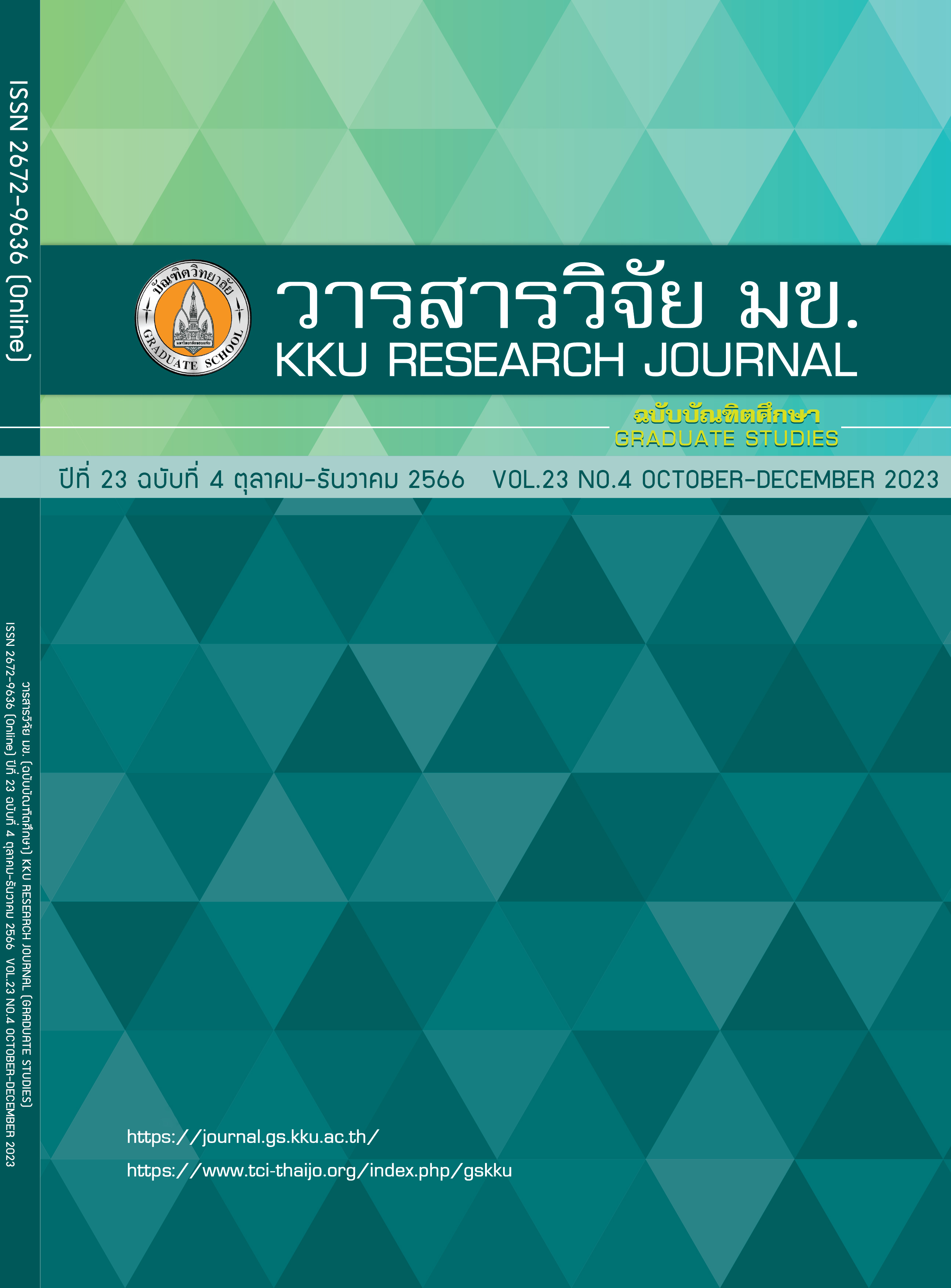ผลของการฝึกระยะสั้นของการออกกำลังกายด้วยแบบรีโพสิชันต่อภาวะศีรษะยื่นและไหล่งุ้มในนักกีฬาว่ายน้ำระดับมหาวิทยาลัย
คำสำคัญ:
การออกกำลังกายแบบรีโพสิชัน, ศีรษะยื่น, ไหล่งุ้มบทคัดย่อ
การศึกษาครั้งนี้มีวัตถุประสงค์เพื่อวิเคราะห์ ผลระยะสั้นของการออกกำลังกายแบบรีโพสิชันต่อการเปลี่ยนแปลงภาวะศีรษะยื่นและไหล่งุ้มในนักกีฬาว่ายน้ำระดับมหาวิทยาลัย อาสาสมัครในครั้งนี้คือ นักกีฬาว่ายน้ำของชมรมกีฬาทางน้ำ ของมหาวิทยาลัยขอนแก่น เพศชาย จำนวน 36 คน มีอายุเฉลี่ย 21.58±1.98 ปี น้ำหนักเฉลี่ย 73.42±12.10 ส่วนสูงเฉลี่ย 1.75±0.05 เมตร ดัชนีมวลกายเฉลี่ย 23.97±3.46 โดยแบ่งอาสาสมัครออกเป็น 2 กลุ่มด้วยวิธีการสุ่มแบบบล็อก กลุ่มออกกำลังกายแบบรีโพสิชันคือกลุ่มที่ 1 จะได้ทำการออกกำลังกายแบบรีโพสิชัน จำนวน 3 ครั้งต่อสัปดาห์ ครั้งละประมาณ 30 นาที เป็นระยะเวลา 4 สัปดาห์ โดยมีผู้วิจัยเป็นผู้ควบคุมและดูแลการออกกำลังกาย ส่วนกลุ่มควบคุมคือกลุ่มที่ 2 ที่ทำการฝึกซ้อมการว่ายน้ำตามปกติ ตัวแปรในการศึกษา ได้แก่ การทดสอบค่าวัดมุมของศีรษะและคอศีรษะ ค่าดัชนีความงุ้มของหัวไหล่ คะแนนแบบสอบถาม DASH-SM และเวลาในการว่ายน้ำท่าฟรีสไตล์ในระยะทาง 50 เมตร โดยประเมินก่อนทำการวิจัย (สัปดาห์ที่ 1) และสิ้นสุดการวิจัย (สัปดาห์ที่ 4) ผลการทดลองพบว่า เมื่อเปรียบเทียบผลของการฝึกต่อการเปลี่ยนแปลงของตัวแปรภายในกลุ่มในสัปดาห์ที่ 4 พบว่ากลุ่มออกกำลังกายแบบรีโพสิชันมีตัวแปรที่มีค่าเพิ่มขึ้นอย่างมีนัยสำคัญทางสถิติ ได้แก่ ค่ามุมของศีรษะและคอ (p=0.001) ค่าดัชนีความงุ้มของหัวไหล่ด้านขวา (p=0.001) คะแนนของแบบสอบถาม DASH-SM (p=0.03) และเวลาในการว่ายน้ำท่าฟรีสไตล์ในระยะทาง 50 เมตรลดลงอย่างมีนัยสำคัญทางสถิติ (p=0.019) แต่กลุ่มควบคุมไม่มีความแตกต่างภายในกลุ่มทุกตัวแปร และเมื่อเปรียบเทียบผลของการฝึกต่อการเปลี่ยนแปลงของตัวแปรระหว่างกลุ่มพบว่าไม่มีความแตกต่างอย่างมีนัยสำคัญทางสถิติทุกตัวแปร สรุปผลการทดลองพบว่า ถ้าหากเพิ่มระยะเวลาในการออกกำลังกาย หรือปรับเปลี่ยนท่าออกกำลังกาย อาจจะส่งผลให้มีความแตกต่างที่ชัดเจนมายิ่งขึ้น และช่วยแก้ไขภาวะศีรษะยื่นและไหล่งุ้ม รวมไปถึงช่วยลดการบาดเจ็บของหัวไหล่ และเพิ่มสมรรถภาพของนักกีฬาว่ายน้ำได้
เอกสารอ้างอิง
Barbosa TM, Marinho DA, Costa MJ, Silva AJ. Biomechanics of Competitive Swimming Strokes. Biomechanics in Applications. 2011;23.
Johnson JE, Sim FH, Scott SG. Musculoskeletal Injuries in Competitive Swimmers. Mayo Clinic Proceedings. 1987 Apr;62(4):289–304.
Stocker D, Pink M, Jobe FW. Comparison of shoulder injury in collegiate- and master’s-level swimmers. Clinical journal of sport medicine: official journal of the Canadian Academy of Sport Medicine. 1995;5(1):4–8.
Pink MM, Tibone JE. THE PAINFUL SHOULDER IN THE SWIMMING ATHLETE. Orthopedic Clinics of North America. 2000;31(2):247–261.
Allegrucci M, Whitney SL, Irrgang JJ. Clinical Implications of Secondary Impingement of the Shoulder in Freestyle Swimmers. J Orthop Sports Phys Ther. 1994 Dec;20(6):307–318.
Asundi K, Odell D, Luce A, Dennerlein JT. Changes in posture through the use of simple inclines with notebook computers placed on a standard desk. Applied Ergonomics. 2012 Mar;43(2):400–407.
Janda V. Muscles and motor control in low back pain : assessment and management. In Churchill Livingstone, New York; 1987.
Kang JI, Choi HH, Jeong DK, Choi H, Moon YJ, Park JS. Effect of scapular stabilization exercise on neck alignment and muscle activity in patients with forward head posture. J Phys Ther Sci. 2018;30(6):804–808.
Kendall, McCreary EK. Muscles, Testing and Function (Third Edition). Br J Sports Med. 1984 Mar;18(1):25.
McMaster WC, Troup J. A survey of interfering shoulder pain in United States competitive swimmers. Am J Sports Med. 1993 Jan;21(1):67–70.
Hruska R, Anderson J. Postural respiration – an integrated approach to treatment of patterned thoraco-abdominal pathomechanics. Chapel Hill, North Carolina; 2019
Jantoon N, Uthaikhup S. Effects of an exercise program on cervical posture and sensorimotor function in persons with forward head posture. :10.
Lau HMC, Chiu TTW, Lam TH. Measurement of craniovertebral angle with Electronic Head Posture Instrument: Criterion validity. JRRD. 2010;47(9):911.
Borstad JD. Measurement of Pectoralis Minor Muscle Length: Validation and Clinical Application. J Orthop Sports Phys Ther. 2008 Apr;38(4):169–174.
Sharma A, Sharma A, Mishra A, Maini D, Sharma P, Verma T. Pectoralis Minor Index: Does Ethnicity Hold Relevance? Estimation of Pectoralis Minor Length in the Indian Population and Its Correlation with Hand Length. JOIO. 2020 May;54(3):374–380.
Buntragulpoontawee M, Phutrit S, Tongprasert S, Wongpakaran T, Khunachiva J. Construct validity, test–retest reliability and internal consistency of the Thai version of the disabilities of the arm, shoulder and hand questionnaire (DASH-TH) in patients with carpal tunnel syndrome. BMC Research Notes. 2018 Mar 27;11(1):208.
Greenfield B, Catlin PA, Coats PW, Green E, McDonald JJ, North C. Posture in Patients With Shoulder Overuse Injuries and Healthy Individuals. J Orthop Sports Phys Ther. 1995 May;21(5):287–295.
Kluemper M, Uhl T, Hazelrigg H. Effect of Stretching and Strengthening Shoulder Muscles on Forward Shoulder Posture in Competitive Swimmers. Journal of Sport Rehabilitation. 2006 Feb;15(1):58–70.
Kim HJ, Lee D. The study of correlation between forward head posture and shoulder pain: A STROBE-compliant cross-sectional study. Phys Ther Rehabil Sci. 2021 Sep 30;10(3):251–256.
Mougios V, Deligiannis A. Effect of water temperature on performance, lactate production and heart rate at swimming of maximal and submaximal intensity. The Journal of sports medicine and physical fitness. 1993;33 1:27–33.
ดาวน์โหลด
เผยแพร่แล้ว
ฉบับ
ประเภทบทความ
สัญญาอนุญาต
ลิขสิทธิ์ (c) 2023 วารสารวิจัย มข. (ฉบับบัณฑิตศึกษา)

อนุญาตภายใต้เงื่อนไข Creative Commons Attribution-NonCommercial-NoDerivatives 4.0 International License.



